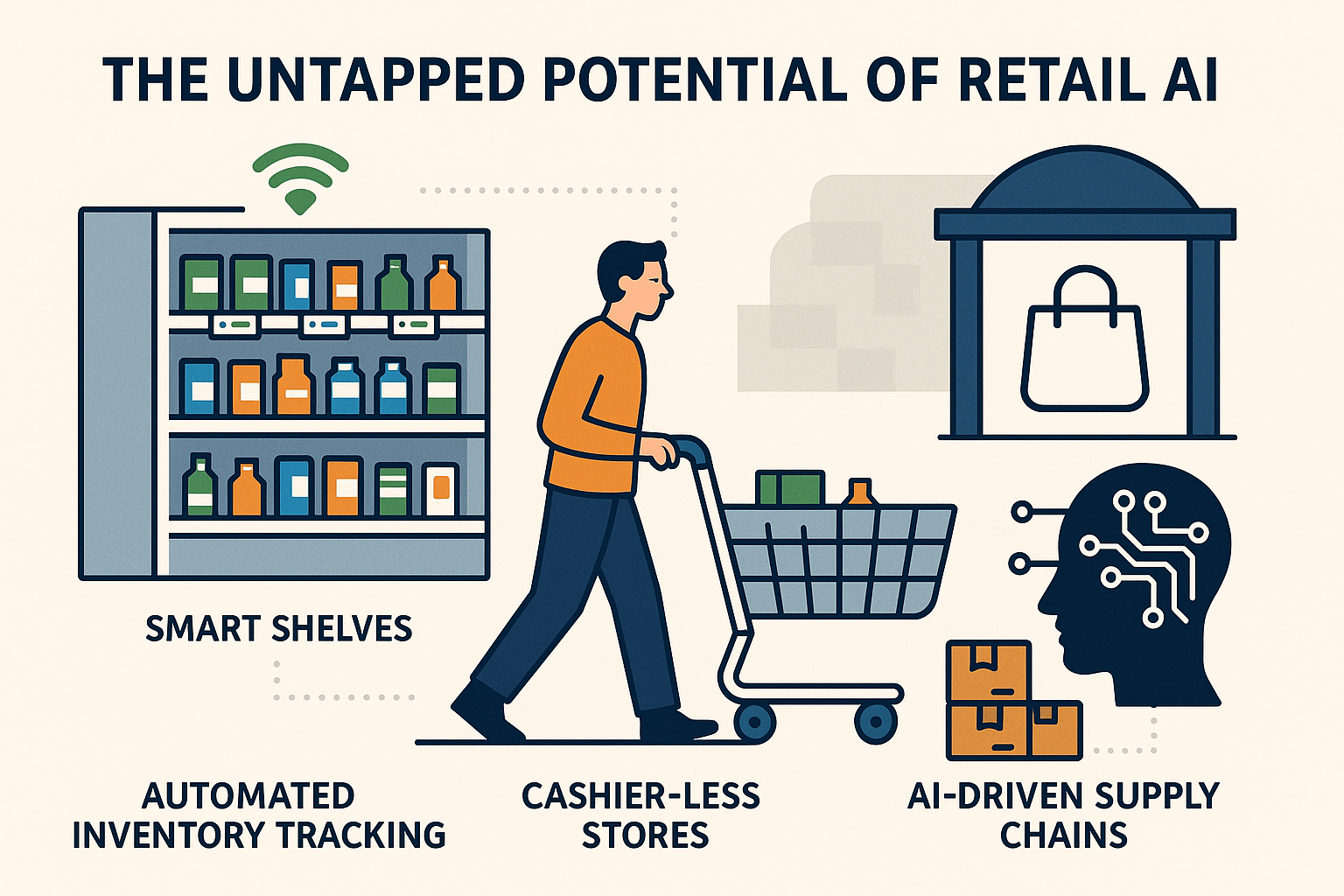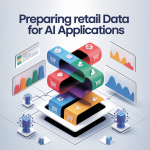
The Untapped Potential of Retail AI: From Smart Shelves to Autonomous Stores, How AI is Changing Retail Forever
Retail is undergoing a seismic transformation, one that is being quietly but powerfully driven by Artificial Intelligence (AI).
While many retailers have dabbled with customer-facing AI—think chatbots and product recommendations—the true potential of AI runs far deeper.
From intelligent shelf systems and autonomous checkout to predictive logistics and hyper-personalized experiences, AI is not just optimizing retail—it’s reimagining it.
This report explores the untapped potential of AI in retail, covering innovations such as smart shelves, automated inventory tracking, cashier-less stores, and AI-driven supply chains.
These tools are not simply conveniences; they are reshaping operational norms and fundamentally altering consumer expectations.
1. Smart Shelves and Real-Time Inventory Visibility
The Problem of Out-of-Stocks
Retailers lose billions of dollars annually due to stockouts, misplaced items, and inventory mismanagement.
Smart shelves aim to eliminate this friction point through embedded sensors and real-time AI analytics.
How Smart Shelves Work
Smart shelves use a combination of:
-
Weight sensors and RFID tags to detect item removal or restocking.
-
Computer vision to recognize product placement and alert staff to restocking needs or planogram compliance issues.
-
AI algorithms to learn restocking patterns, predict product demand, and trigger reordering automatically.
Benefits
-
Real-time inventory tracking
-
Reduced labor costs for stock audits
-
Enhanced planogram compliance
-
Fewer lost sales due to stockouts
Retail Examples
-
Kroger has partnered with Microsoft to develop EDGE smart shelves that display pricing and product information dynamically.
-
Walmart uses shelf-scanning robots to track inventory, reduce human error, and restock efficiently.
Smart shelves represent the convergence of IoT and AI, offering a powerful feedback loop between physical stores and digital systems.
2. Computer Vision and Frictionless Checkout
From Self-Checkout to No Checkout
Retailers initially introduced self-checkout kiosks to improve speed and reduce labor costs, but friction remained.
AI has now enabled a more radical step—frictionless checkout, where no scanning or cashier is required.
How It Works
Through computer vision, machine learning, and sensor fusion, these systems:
-
Identify which products are picked up or returned by customers
-
Track individuals using overhead cameras
-
Automatically charge customers as they walk out
Leading Players
-
Amazon Go pioneered the concept with its Just Walk Out technology.
-
AiFi and Standard Cognition are offering scalable alternatives to global retailers and convenience stores.
Benefits
-
Eliminates checkout lines
-
Reduces theft through advanced tracking
-
Improves store layout by analyzing traffic patterns
-
Enhances convenience, appealing to time-strapped shoppers
This level of automation reshapes what consumers expect from a shopping experience—instant, seamless, and personalized.
3. AI-Driven Inventory Management and Demand Forecasting
Why Traditional Forecasting Falls Short
Conventional inventory systems are reactive, relying on historical sales trends. In contrast, AI uses predictive analytics to anticipate needs before they arise.
AI Capabilities
-
Weather and event-based demand forecasting
-
SKU-level replenishment optimization
-
Dynamic pricing models
-
Shrinkage and waste reduction
Key Technologies
-
Machine Learning: Learns from years of sales, external conditions (weather, holidays), and competitor pricing.
-
Natural Language Processing (NLP): Interprets product reviews and social media signals to predict shifts in demand.
-
Reinforcement Learning: Continuously improves based on inventory performance and outcomes.
Case Study
-
Zara uses AI for rapid demand forecasting, helping to restock fast-moving items in weeks rather than months.
-
Target leverages AI to automate DC-to-store inventory flows, reducing out-of-stocks and overstock scenarios.
4. Autonomous Stores and Robotics
Robotics Meet Retail
Retailers are increasingly using autonomous robots for:
-
Shelf auditing
-
Cleaning
-
Product picking
-
Delivery
These robots are often equipped with AI-based vision systems, enabling them to navigate store layouts and interact with inventory in a human-like way.
Autonomous Stores: The Next Frontier
Autonomous stores go beyond checkout-free shopping. They are staff-less environments where everything from stocking to customer service is augmented by AI.
-
AI chatbots or voice assistants answer questions
-
Sensors and cameras manage security
-
Automated logistics manage restocking
These environments drastically reduce labor costs while increasing operational hours.
Examples
-
7-Eleven Japan is piloting robotic shelf-stocking systems.
-
Alibaba’s Hema stores combine digital interfaces, automated kitchen preparation, and app-based shopping into one futuristic model.
5. AI in Supply Chain Optimization
The Supply Chain Gets Smart
AI has become the backbone of modern supply chains. From procurement to final delivery, AI systems enhance:
-
Route planning
-
Warehouse automation
-
Supplier risk analysis
-
Cold-chain management
How It Works
-
Predictive AI anticipates delays due to weather, port issues, or demand spikes.
-
Prescriptive AI suggests solutions like re-routing or supplier diversification.
-
Generative AI is even being explored to design more efficient logistics models.
Impact
-
Lower operating costs
-
Shorter delivery times
-
More sustainable practices through optimized transport
-
Greater resilience to disruption (e.g., pandemics, geopolitical issues)
Companies like Ocado and Amazon are leaders in AI-optimized warehousing and delivery, setting new standards in speed and efficiency.
6. Personalized Shopping at Scale
Beyond Recommendations
AI-driven personalization now spans every touchpoint:
-
Website and app interfaces adapt to individual behavior
-
In-store digital signage offers tailored promotions
-
Email campaigns respond dynamically to browsing history
Hyper-Personalization in Action
AI doesn’t just segment audiences—it creates unique experiences:
-
Beauty brands like Sephora use AI tools to recommend products based on skin tone and goals
-
Fashion retailers like ASOS use computer vision to recommend similar styles
-
Grocery chains offer personalized coupons and recipes through AI-powered loyalty programs
This type of real-time personalization drives higher conversion, loyalty, and basket size.
7. AI-Powered Customer Service
From FAQ Bots to Emotional Intelligence
Customer service bots are becoming more than just scripted responders. With Natural Language Understanding (NLU), they now:
-
Understand context and emotion
-
Resolve complex queries
-
Escalate when needed—intelligently
Omnichannel Integration
AI systems unify conversations across platforms—chat, phone, social media—offering consistent and efficient experiences.
Voice Assistants
Smart speakers and in-store voice kiosks are making it easier for customers to interact with brands.
Integration with AI systems ensures real-time responses, stock availability updates, and seamless transactions.
8. Ethics, Data Privacy, and the Human Factor
Concerns and Cautions
As AI becomes deeply embedded in retail, ethical concerns rise:
-
Bias in algorithms affecting product placement or pricing
-
Surveillance concerns from in-store cameras and facial recognition
-
Job displacement for frontline workers
Responsible AI in Retail
Retailers must:
-
Be transparent about data use
-
Prioritize consent and privacy
-
Design AI that augments human roles, not just replaces them
Many retailers now employ AI ethics officers or committees to guide development.
9. The Future of Retail: AI as the Operating System
We’re moving toward a world where AI becomes the operating system of retail, seamlessly integrating:
-
Supply chain logistics
-
Store operations
-
Customer interactions
-
Strategic planning
This will lead to:
-
Adaptive merchandising: Stores that change layouts and inventory based on predictive foot traffic.
-
AI-native brands: Companies built from day one with AI at the core, not as a bolt-on.
-
Mixed-reality experiences: AI-powered AR/VR overlays that merge digital and physical retail.
The retailers who thrive will be those who don’t just use AI tools but think with AI as a co-pilot for decision-making.
Conclusion: A Retail Revolution in Progress
AI is no longer a futuristic option—it’s a present-day imperative. Yet much of its potential remains untapped, particularly in small to mid-sized retail operations. The good news is that scalable AI tools, cloud services, and open-source solutions are lowering the barrier to entry.
The revolution isn’t just about robots or high-tech stores. It’s about creating smarter, more agile, and more human-centered retail experiences—where convenience, personalization, and operational excellence converge.
For retailers willing to embrace the full spectrum of AI—from shelf to supply chain—the future isn’t just promising. It’s already here.


